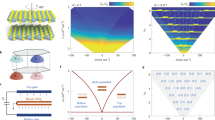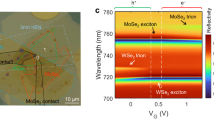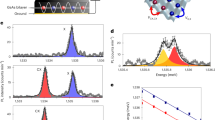Abstract
An exciton is the particle-like entity that forms when an electron is bound to a positively charged ‘hole’. An ordered electronic state in which excitons condense into a single quantum state was proposed as a theoretical possibility many years ago. We review recent studies of semiconductor bilayer systems that provide clear evidence for this phenomenon and explain why exciton condensation in the quantum Hall regime, where these experiments were performed, is as likely to occur in electron–electron bilayers as in electron–hole bilayers. In current quantum Hall excitonic condensates, disorder induces mobile vortices that flow in response to a supercurrent and limit the extremely large bilayer counterflow conductivity.
This is a preview of subscription content, access via your institution
Access options
Subscribe to this journal
Receive 51 print issues and online access
$199.00 per year
only $3.90 per issue
Buy this article
- Purchase on Springer Link
- Instant access to full article PDF
Prices may be subject to local taxes which are calculated during checkout




Similar content being viewed by others
References
Keldysh, L. V. & Kopaev, Y. V. Possible instability of the semimetallic state with respect to coulombic interaction. Fiz. Tverd. Tela. 6, 2791 (1964)
Snoke, D. Spontaneous Bose coherence of excitons and polaritons. Science 298, 1368–1372 (2002)
Butov, L. V. Exciton condensation in coupled quantum wells. Solid State Commun. 127, 89–98 (2003)
Lozovik, Yu. E. & Yudson, V. I. Novel mechanism of superconductivity—pairing of spatially separated electrons and holes. Zh. Eksp. Teor. Fiz. 71, 738–753 (1976); Sov. Phys. JETP 44, 389–397 (1976)
Shevchenko, S. I. Theory of superconductivity of systems with pairing of spatially separated electrons and holes. Fiz. Nizk. Temp. 2, 505 (1976); Sov. J. Low-Temp. Phys. 2, 251–256 (1976)
Butov, L. V. et al. Condensation of indirect excitons in coupled AlAs/GaAs quantum wells. Phys. Rev. Lett. 73, 304–307 (1994)
Butov, L. V., Gossard, A. C. & Chemla, D. S. Macroscopically ordered state in an exciton system. Nature 418, 754–757 (2002)
Konig, J., Bonsager, M. C. & MacDonald, A. H. Dissipationless spin transport in thin film ferromagnets. Phys. Rev. Lett. 87, 187202–187204 (2001)
Tsui, D. C., Stormer, H. L. & Gossard, A. C. Two-dimensional magnetotransport in the extreme quantum limit. Phys. Rev. Lett. 48, 1559–1562 (1982)
Rezayi, E. H. & MacDonald, A. H. Fractional quantum Hall effect in a two-dimensional electron-hole fluid. Phys. Rev. B 42, 3224–3227 (1990)
Yoshioka, D. & MacDonald, A. H. Double quantum-well electron-hole systems in strong magnetic fields. J. Phys. Soc. Jpn 59, 4211–4214 (1990)
Fertig, H. Energy spectrum of a layered system in a strong magnetic field. Phys. Rev. B 40, 1087–1095 (1989)
Wen, X. G. & Zee, A. Neutral superfluid modes and ‘magnetic’ monopoles in multilayered quantum Hall systems. Phys. Rev. Lett. 69, 1811–1814 (1992)
Kuramoto, Y. & Horie, C. Two-dimensional excitonic phase in strong magnetic fields. Solid State Commun. 25, 713–716 (1978)
Eisenstein, J. P., Boebinger, G. S., Pfeiffer, L. N., West, K. W. & He, Song New fractional quantum Hall state in double-layer two-dimensional electron systems. Phys. Rev. Lett. 68, 1383–1386 (1992)
Spielman, I. B., Eisenstein, J. P., Pfeiffer, L. N. & West, K. W. Resonantly enhanced tunneling in a double layer quantum hall ferromagnet. Phys. Rev. Lett. 84, 5808–5811 (2000)
Eisenstein, J. P., Pfeiffer, L. N. & West, K. W. Independently contacted two-dimensional electron-systems in double quantum wells. Appl. Phys. Lett. 57, 2324–2326 (1990)
Kellogg, M., Eisenstein, J. P., Pfeiffer, L. N. & West, K. W. Vanishing Hall resistance at high magnetic field in a double layer two-dimensional electron system. Phys. Rev. Lett. 93, 036801 (2004)
Tutuc, E., Shayegan, M. & Huse, D. Counterflow measurements in strongly correlated GaAs hole bilayers: evidence for electron-hole pairing. Phys. Rev. Lett. 93, 036802 (2004)
Kohn, W. & Sherrington, D. Two kinds of bosons and Bose condensates. Rev. Mod. Phys. 42, 1–11 (1970)
Abolfath, M., Radzihovsky, L. & MacDonald, A. H. Critical currents of ideal quantum Hall superfluids. Phys. Rev. B 68, 155318 (2003)
Shevchenko, S. I. Phase diagram of systems with pairing of spatially separated electrons and holes. Phys. Rev. Lett. 72, 3242–3245 (1994)
Moon, K., Mori, H., Yang, K., Girvin, S. M. & MacDonald, A. H. Spontaneous interlayer coherence in double-layer quantum Hall systems: Charged vortices and Kosterlitz-Thouless phase transitions. Phys. Rev. B 51, 5138–5170 (1995)
Acknowledgements
This research was supported by the National Science Foundation (J.P.E. and A.H.M.) and the Department of Energy (J.P.E.). We thank A. Burkov, Y. Joglekar, M. Kellogg, L. Pfeiffer, E. Rossi, I. Spielman and K. West for their essential help in this research.
Author information
Authors and Affiliations
Corresponding author
Ethics declarations
Competing interests
The authors declare that they have no competing financial interests.
Rights and permissions
About this article
Cite this article
Eisenstein, J., MacDonald, A. Bose–Einstein condensation of excitons in bilayer electron systems. Nature 432, 691–694 (2004). https://doi.org/10.1038/nature03081
Received:
Accepted:
Issue Date:
DOI: https://doi.org/10.1038/nature03081
This article is cited by
-
Observation of possible excitonic charge density waves and metal–insulator transitions in atomically thin semimetals
Nature Physics (2024)
-
Atomic-scale visualization of the interlayer Rydberg exciton complex in moiré heterostructures
Nature Communications (2024)
-
Twistronics and moiré excitonic physics in van der Waals heterostructures
Frontiers of Physics (2024)
-
Recent progress of exciton transport in two-dimensional semiconductors
Nano Convergence (2023)
-
Josephson–Coulomb drag effect between graphene and a LaAlO3/SrTiO3 superconductor
Nature Physics (2023)
Comments
By submitting a comment you agree to abide by our Terms and Community Guidelines. If you find something abusive or that does not comply with our terms or guidelines please flag it as inappropriate.



